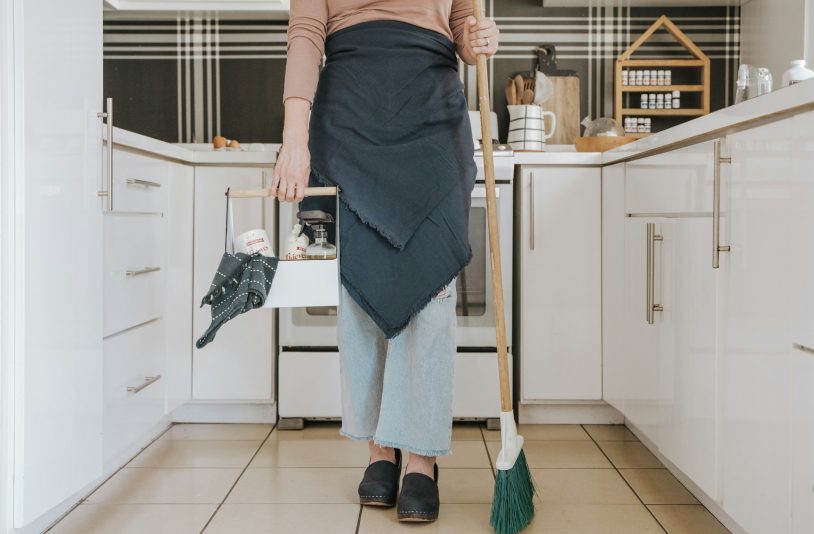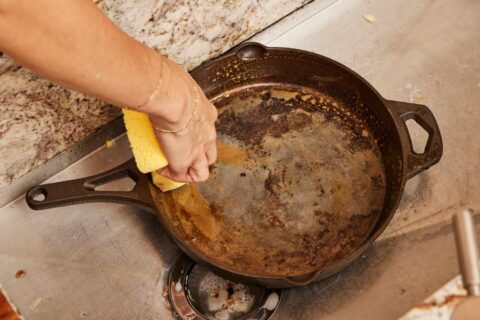
Sweeping the floor might seem like a simple chore, but doing it right can make a big difference in how clean your home feels. Whether you’re tidying up a small apartment or keeping a large space dust-free, using the correct tools and techniques can save you time and effort.
In this guide, we’ll walk you through the best way to sweep a floor, from choosing the right broom to avoiding common mistakes. With a bit of know-how, you’ll be sweeping like a pro in no time!
Keep reading to learn how to sweep a floor the right way!
Jump to Section [Hide]
Step 1: Gather the Right Tools
Get the proper tools to match your floor type. The right broom and dustpan make sweeping easier and faster.
Types of brooms
There are different brooms for different tasks. Indoor brooms usually have soft bristles, which work well on delicate floors like tile or hardwood. Outdoor brooms often have stiff bristles, which handle rough surfaces, such as cement or driveways.
Angled bristle brooms help you clean edges and corners better. Push brooms are great for large spaces, while whisk brooms handle small messes quickly. Keep the right broom for each surface type handy to make sweeping easier and faster!
Best broom for floor types
Choose an indoor broom for delicate floors like tile or hardwood. Its soft, angled bristles clean without scratching. For rough surfaces, use an outdoor broom with stiff bristles. It handles dirt and debris on concrete or driveways easily.
Try small brooms for tight spaces and corners. Use larger ones for big areas to save time. Rubber brooms work well on pet hair and hard-to-remove messes. Match your broom to the flooring type for the best results in floor cleaning!
Selecting the right dustpan
Pick a long-handled dustpan to avoid bending over. This makes sweeping more comfortable and saves your back. The dustpan should be wide enough to catch all the dirt in one go, preventing leftover debris.
Look for a dustpan with a rubber edge. It helps trap small particles like sand or crumbs on tile floors. Machine washable options are great for easy cleaning after use.
Step 2: Prepare the Area
Clear the space to make sweeping easier and faster. Keep rugs, furniture, and other items out of the way for better access.
Remove furniture and clutter
Move chairs, tables, and other furniture out of the way. This creates a clear path for sweeping floors.
Pick up items like toys, shoes, or books from the floor. A clutter-free space makes cleaning faster and easier.
Shake out rugs and mats
Take rugs and mats outside. Shake them firmly to remove dirt, crumbs, or hair. This step keeps floors cleaner during sweeping. Mats trap grime over time, so this prevents spreading it back onto the floor.
If available, use a microfiber cloth for stubborn dust on small mats. Clean each thoroughly before bringing them in again. Keeping mats clean helps with household management and saves extra cleaning later.
Close windows and turn off fans
Close all windows before sweeping. This keeps dust from blowing back inside, and open windows can spread dirt, making cleaning harder.
Turn off the fans to stop dust from flying around. Fans lift debris into the air, undoing your work. A calm space helps you clean faster and better.
Step 3: Break Large Spaces into Sections
Tackle one section at a time to make the job easier.
Divide the area for easier cleaning
Separate large rooms into smaller sections. This makes cleaning faster and more effective. Use furniture or rugs as natural markers to divide the space.
Focus on cleaning one section at a time. It helps ensure you don’t miss spots in your home. This approach works well for both open areas and tight corners.
Focus on one section at a time
Divide the floor into smaller areas. This makes cleaning faster and easier. Work on one section completely before moving to the next. Start at the farthest corner of that area, then sweep systematically.
Sweep debris into a pile as you go to keep dirt from spreading. Make sure each space is clear before continuing. Follow these steps to avoid missing spots or doubling your work.
Step 4: Begin Sweeping
Start at the farthest corner and work your way back with steady strokes. Your floor will thank you!
Start from the farthest corners
Begin in the farthest corner of the room. This keeps you from stepping on clean areas later. Work your way toward the door to avoid trapping dirt where you’ve already swept.
Use short, firm strokes for better control. Sweep debris toward yourself, not away. This prevents scattering dirt into other sections of the floor. Focus on edges and corners as dust often hides there.
Use short, deliberate strokes
Use firm, short strokes while sweeping. These keep dust from rising into the air and spreading everywhere. Sweep in small, one to two-foot sections for more control. This method works better than long, wide sweeps that scatter dirt.
Keep your movements steady and gentle on the broom bristles. Too much force can damage them over time or push debris away instead of gathering it. Focus on guiding dirt neatly into place as you move along each section of the floor.
Sweep toward yourself, not away
Always pull the broom toward yourself. This keeps dust and debris under control. Pushing away can spread dirt into the air or onto clean areas.
Short strokes work best for this method. Start at the edges of your section, then move inward. Use a squeegee-style motion on smooth floors like tile or hardwood to gather everything effectively.
Cover all edges and hard-to-reach spots
Sweep along walls, baseboards, and corners. Dust collects quickly in these areas. Use the broom’s tip to reach tight spaces, such as under furniture or behind doors.
Tackle hard-to-reach spots like under appliances or close to blinds. A small hand broom works well for narrow gaps. Make sure no dirt piles remain hidden.
Step 5: Collect the Dirt
Gather all the dust into one spot to keep things tidy. Use your tools carefully to avoid leaving any mess behind.
Sweep debris into a central pile
Move the broom in small strokes. Push debris into one spot on the floor, making it easier to collect later. Sweep gently so dirt stays in place and doesn’t scatter.
If you are working in a large room first, create smaller piles, then combine them into one central pile. This saves time and keeps your space tidier as you work.
Use the dustpan correctly to avoid leftover lines
Place the dustpan flat against the floor. Make sure it lines up tightly to avoid gaps. Use a long-handled dustpan for better control and ease.
Sweep debris directly into it using firm strokes. If dirt is left behind in a line, press harder or adjust the angle slightly. Check the edges of the pile to ensure no crumbs are missed before disposing of everything properly.
Step 6: Dispose of Debris Properly
Empty the dustpan into the nearest trash bin quickly. Check for loose dirt to keep your space tidy and clean.
Empty the dustpan into the trash or recycling bin
Dump the dirt into a trash can or recycling bin. If you have recyclable items like paper scraps, make sure to use the right bin.
Check for any leftover dust in the dustpan. Tap it lightly to remove stubborn bits stuck inside.
Double-check for remaining dirt
Look closely at the floor after sweeping. Check corners, under furniture, and edges for missed spots. Use your broom to sweep any leftover dirt into the dustpan.
Make sure no debris is left behind. If needed, run your hand lightly over areas to feel for grit. Properly empty all collected dirt into a trash can or recycling bin.
Cleaning and Maintaining Your Broom
Keep your broom in top shape with simple care steps. A clean broom works better and lasts longer!
Shake out or wash the broom as needed
Shake out the broom outdoors to remove dust. This stops dirt from spreading back onto your clean floor.
If the bristles get too dirty, wash them with warm, soapy water. Let the broom dry completely before storing it upright.
Store upright to preserve bristles
When storing your broom, keep it standing upright. This keeps the bristles off the floor and helps them stay straight. Bristles that bend or flatten make sweeping harder.
Dry wet bristles upside down to avoid damage. A broom with damaged bristles will not clean well and might leave dirt behind. Proper storage also makes your cleaning tools last longer.
Avoid Common Sweeping Mistakes
Skipping steps can make sweeping harder. Using the right tools and methods keeps your floor cleaner.
Sweeping without preparing the area
Clutter left on the floor makes sweeping harder. Move furniture and pick up loose items before starting. Shake out rugs and mats to remove hidden dirt.
Open windows or fans can spread dust. Close them to keep everything in one spot, which saves time and effort during cleaning.
Using the wrong broom type
Using the wrong broom can damage your floors. Indoor brooms work best for delicate floors like hardwood or tile. Outdoor brooms are tougher and handle rough surfaces like concrete or patios.
Choose wisely to make sweeping easier. A soft-bristle broom works well on smooth surfaces indoors, while sturdy bristles clear dirt from uneven outdoor areas. Using the right tool protects your floor while saving time and effort!
Ignoring corners or sweeping too quickly
Dust hides in corners and edges. If you skip these spots, your floor will not be fully clean. Use deliberate strokes to reach every corner.
Sweeping too fast leaves debris behind. Slow down and move the broom carefully. This helps pick up all dirt without missing any areas.
Importance of sweeping correctly
Sweeping the right way keeps your home cleaner and safer. It stops dirt and dust from flying back into the air, improving indoor air quality. This is especially important if you have allergies or asthma.
A proper sweeping routine saves time, too, as you won’t need to deep clean as often.
Doing it wrong can miss hidden spots like corners or edges. Skipping steps might push debris around instead of removing it. Use tools like a suitable broom for your floor type and a tight-sealing dustpan to prevent leftover messes.
Keeping things tidy makes homemaking easier and healthier every day!
The Bottom Line
Keeping your floors clean is easy if you follow the right steps. Use proper tools and choose the best broom for your floor type. Prepare the area before starting. Work in sections to make cleaning simple and quick.
Pay attention to corners and edges so no dirt stays behind. Start sweeping today, and enjoy a neat, tidy space








